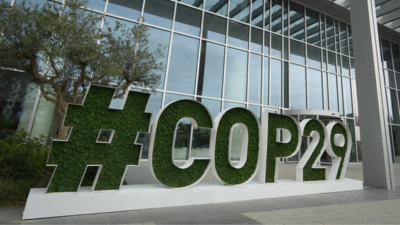
COP29 (AP photo) BAKU: Giving much needed talking points around nature and quality of new post-2025 climate finance at UN climate conference (CO), an independent high-level expert group on the issue on Thursday suggested that negotiations should be focused on mobilising $1 trillion per year by 2030 in “external (public and private) finance from all sources” for investments in emerging market and developing countries (EMDCs), other than China, and about $1.3 trillion by 2035 to deliver the Paris Agreement goals . It also argued that private finance can meet about half of these needs given the changing nature of investment opportunities.
Simply put, the investment needed from external sources for climate action would just be 1% of annual global GDP ($100 trillion) and only half of global defence spending ($2.4 trillion). Observers, who are following the negotiations, believe that the post-2025 climate finance goal will probably be around that figure as it likely matches the annual figure of $1.
3 trillion calculated by developing countries. The share of public and private finance in the overall bouquet will, however, be a big sticking point. The 33-member independent group, tasked by the presidencies to help develop and put forward policy options and recommendations to encourage and enable the public and private investment and finance necessary for delivery of the commitments and targets of the UNFCCC Paris Agreement, also pitched for mobilising the finance at the earliest to save costs.
One of the lead authors of the expert group report and its co-chair, Amar Bhattacharya, however, emphasised that bulk of investment for climate action would, in any case, be domestic finance. “Different kinds of investment need different kinds of finance..
. Largest in terms of amount is for energy transition. It is also clear that a lot of that investment would come from the private sector,” said Bhattacharya.
The report, released on sidelines of CO Thursday, estimates that global projected investment (both external and domestic) requirement for climate action is around $6.3–6.7 trillion per year by 2030, of which $2.
7–2.8 trillion is in advanced economies, $1.3-$1.
4 trillion in China, and $2.3-2.5 trillion in EMDCs other than China.
.














